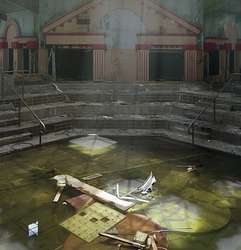Locrian’s approach to metal is to disassemble the core structures, push them further away from their crude beginnings and delve into building them back up again into towering walls of sound and phases of light and dark. Infinite Dissolution is a record that shares small similarities to the genre that it’s born from, mostly in Terence Hannum’s hoarse screams and vocal delivery and the alien, off-world landscapes that are created through traditional elements as well as through electronic patterns and beats. Avant-garde seems too loose a term for Locrian; they feel much more than that and Infinite Dissolution is testament to the fact that over the last decade, Locrian haven’t taken the easy route through the darkness.
Return to Annihilation from 2013 was an outstanding record, yet at times it felt a little incomplete, the passages not quite flowing together as cohesively as they could – perhaps on purpose, perhaps due to the band not yet finding their proverbial feet – but Infinite Dissolution has a wholly impressive unity that follows the opening notes to the closing pain.
The latter half of the record finds itself on more peaceful terms than it did at the beginning as Locrian move onwards and upwards finding light through the darkness. The opening stages of Infinite Dissolution are much more dynamic in tone and style and the industrial thrust of opener “Arc of Extinction” drives the track forward into wounded screams and cascading post-rock melancholy before “Dark Shales” moves into view on mournful guitars and haunting vocal lines. “An Index of Air” marks the turning point in tone for the record but not before it flourishes into raging screams and sorrowful guitar leads. It’s a stunning track where beauty is found in desperate cries and the swell of the chorus beneath it all.
Quieter moments are placed between rising mountains of sound to create space and fluidity in a record that would otherwise be too overwhelming if it continued to pulse and pound for the entire running length. “The Great Dying” is one such composition and the jarring silence it produces between “KXL II” and “Heavy Water” is both intriguing and welcome. Shimmering waves of noise slowly build around a gorgeous choral vocal before “Heavy Water” trips into life on echoing electronic movements that house pained shouts and a sadness that becomes ever more tangible as the track progresses towards final piece, “KXL III.”









